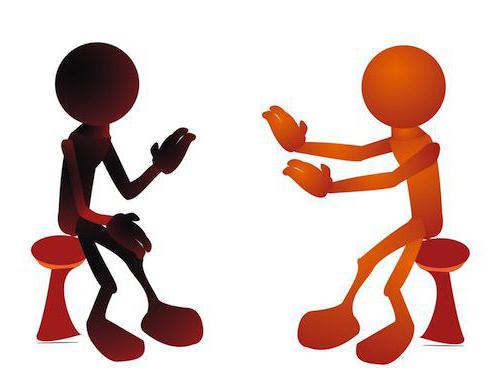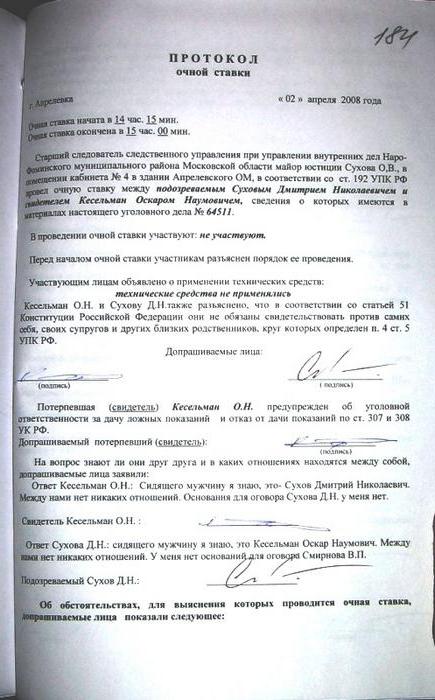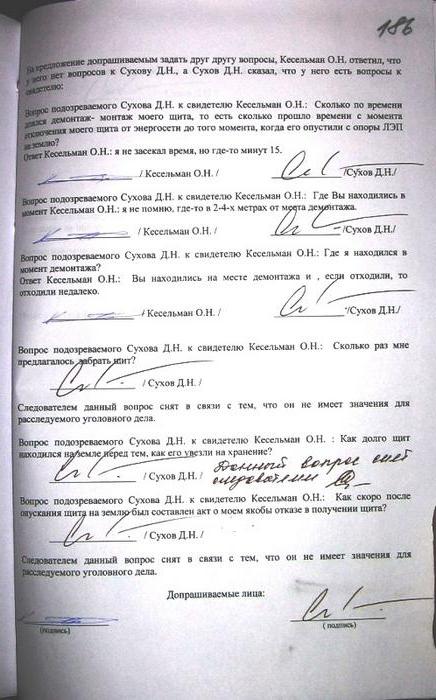A confrontation is a special investigative action. It is carried out in the presence of contradictions in the testimonies of persons participating in the investigation of the case. If the subjects were not previously familiar with each other, identification is performed. 
Procedure specifics
A confrontation is carried out in order to find out which of the persons gave false testimonies. In this case, there is a certain clash of evidence. A confrontation is considered to be a rather effective method of psychological influence on a subject who gave false testimonies. Along with this, when it is carried out, there is a possibility of a negative effect on the person who is telling the truth.
Readings
The results of the investigative action are recorded on video or magnetic tape. However, the confrontation protocol acts as the main means of fixation (an example of the document is presented in the article). Video and sound recording ensure the transmission of speech of persons, its emotional coloring, individual characteristics, the visibility of the investigative action. The face-to-face protocol is evidence of this procedure.
Descriptive part
The investigator is required to correctly draw up the confrontation protocol. The completed sample should contain the fact that the employee clarifies the relationship between the testifying entities, his proposal to them to present their version in turn regarding circumstances for which there are significant contradictions. The document records the questions of the investigator and the persons. Answers are recorded in the face-to-face protocol in the order in which they were given. The document must contain evidence that was given before the investigation. Among them there is information recorded through video and sound recording. Subjects giving testimony and other participants in the procedure may ask their questions with the permission of the investigator. They are also recorded in the face-to-face protocol. The sample may contain applications filed by entities. 
Features of the compilation
In practice, a face-to-face protocol can be set up in two ways. The first option involves dividing each page of the document vertically in half. Questions to one of the testimonies, as well as his answers are recorded in the left column. In the right part, information received from another participant in the procedure is recorded. In the face-to-face protocol, the person interviewed signs his answers on each page. This option of recording the testimony gives a visual representation of the information of the persons about the same facts and circumstances. This facilitates the comparison of information, the identification of contradictions and coincidences in them. However, there is a drawback to this method. A face-to-face protocol filled out in this way may be too lengthy. This is due to the fact that often one subject gives short, and the other - detailed answers to questions. As a result, one part of the document remains almost empty. The investigator crosses out empty places.
Alternate recording
This option allows you to make the face-to-face protocol compact. The document is not divided. It consistently reflects questions and answers. Each person who testifies certifies them with his signature, puts an autograph on each page where they are present. To make it clear who specifically asked the questions, the investigator makes the appropriate instructions: “Question to the accused,” “Response of the accused.”This option of recording readings is optimal when during the procedure it is supposed to change the sequence of the survey. 
Important point
The narrative is executed either during the investigative action, or at the end of it. If during the procedure it is not planned to use video or sound recording, while it is supposed to ask people a lot of questions, it is more expedient to conduct a confrontation protocol during the investigative action. This is due to the fact that subsequently it will be difficult to reproduce the entire sequence of questions and the exact wording of the answers.
Other methods of recording
If the investigator uses video and sound recording during the procedure, then he may not draw up a face-to-face protocol. Sound and video are subsequently easily reproduced and translated into text. Therefore, the investigator has the opportunity to focus directly on the procedure. It must also be emphasized that video and sound fixation act as a deterrent against collusion of subjects who speak a foreign language unknown to the employee. If people still managed to exchange remarks, the investigator can find out their contents using the help of an interpreter. 
Video recording
It is used primarily in cases where testifying subjects have mental or physical disabilities. For example, if deaf-mute, deaf-mute, people with paralysis of the vocal apparatus are interrogated, pretending to be nervous disorders. Video recording is also advisable when testifying by young victims and witnesses, as well as by persons accused of especially serious crimes. This method is also used for complex cross-examination. Investigators analyze the results and develop effective tactics for subsequent actions. Interrogation with the video is carried out in a spacious, evenly lit study with good sound insulation.
It is advisable to conduct a preliminary inspection of the premises. It involves trial video recording, image and sound quality assessment. During the check, suitable shooting areas are selected. The most important conditions for the effectiveness of an investigative action and ensuring the quality of fixation are clarity, conciseness, concreteness of questions, as well as expressiveness of gestures (in those cases when they are appropriate). The key place in the video should be occupied by the subject’s story about the circumstances that he knows, supplemented by answers to questions asked by the investigator.  When shooting a confrontation with presenting persons accusing them of materials, it is necessary to capture this moment and the reaction to the evidence. If testimony is given using signs (for example, using the alphabet of the deaf-mute), emphasis must be placed on gestures. During the sign language translation, a translator must be present in the frame. In the future, this will greatly facilitate verification.
When shooting a confrontation with presenting persons accusing them of materials, it is necessary to capture this moment and the reaction to the evidence. If testimony is given using signs (for example, using the alphabet of the deaf-mute), emphasis must be placed on gestures. During the sign language translation, a translator must be present in the frame. In the future, this will greatly facilitate verification.
Completion of the procedure
The videotape and phonogram are attached to the face-to-face protocol. They allow you to make up for the shortcomings of the written form of recording testimony. The protocol does not accurately reflect the whole face-to-face setting. This, in turn, provokes doubts among stakeholders about the reliability of the information received. Having a video and sound recording of the procedure, the investigator provides confirmation of the evidence recorded in the data protocol. At the end of execution, the document is transmitted for review to all persons who participated in the investigative action and have the right to make clarifications, additions and comments. The protocol must be signed by the investigator and all interrogated entities. Autographs are placed on each page. 
Nuances
To ensure the safety of the witness, the victim, their representatives or close relatives, the investigator may not record personal information about these citizens in the protocol.In such a situation, with the consent of the prosecutor, the employee makes a decision containing the reasons for such a decision, the pseudonym of the person participating in the confrontation is indicated, a sample of his autograph is given, with which he will certify the documents. If the persons refuse to sign, the investigator fixes this fact. This fact is certified by the signature of the employee, as well as the lawyer, legal representative of the person who refused to sign. 
Conclusion
During the confrontation process, a protocol is drawn up. The testimonies of the subjects are recorded in the document in the order in which they were given. The protocol should reflect the questions asked by the investigator, participants to each other, as well as the answers to them. The document is presented for review or is read aloud. Subjects who have testified may require additions, clarifications or changes to the records. The legislation specifically stipulates that each participant should sign their words, each page of the document and the protocol as a whole. The investigator and other persons who were present at the procedure also put their autographs.
